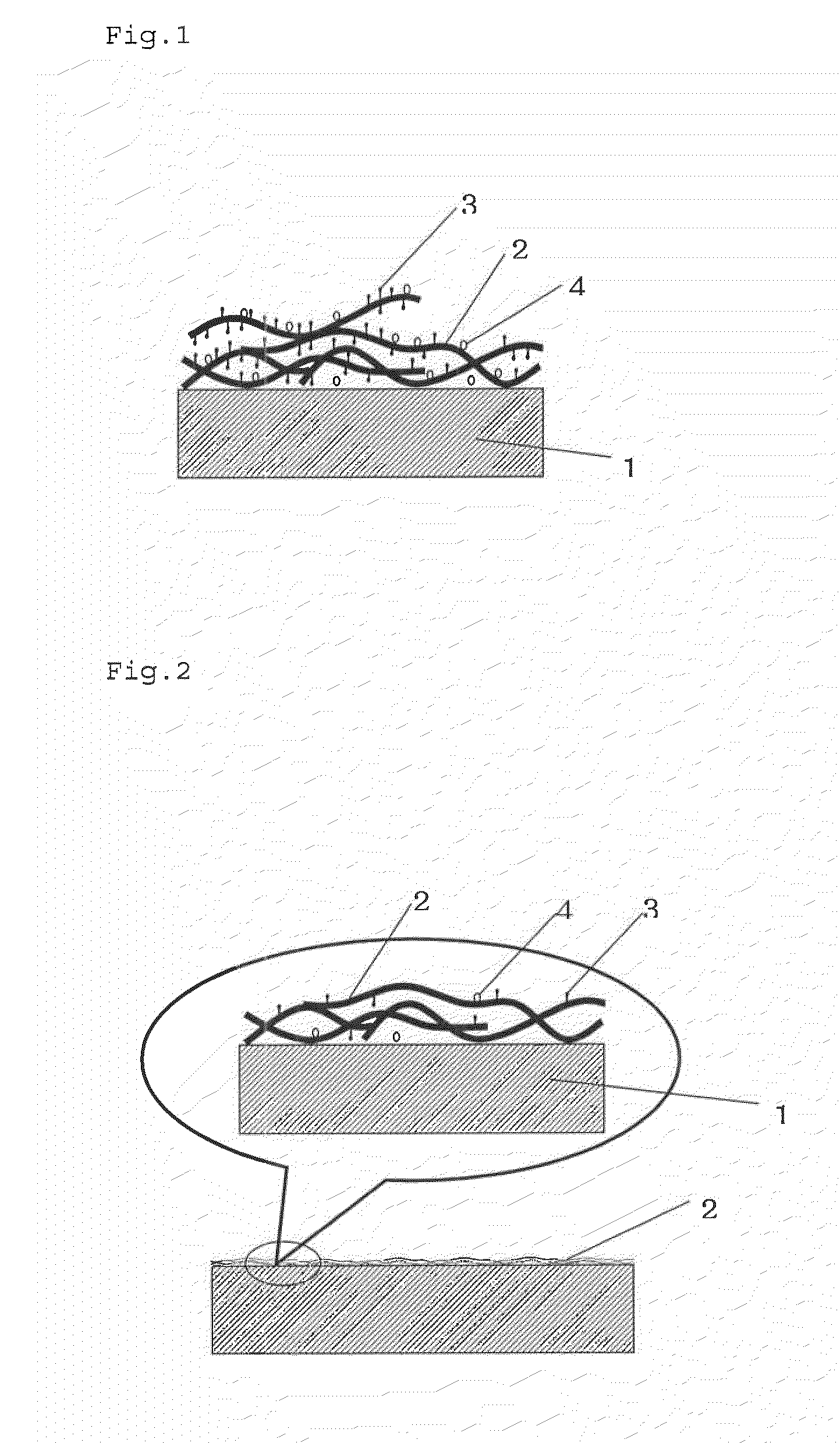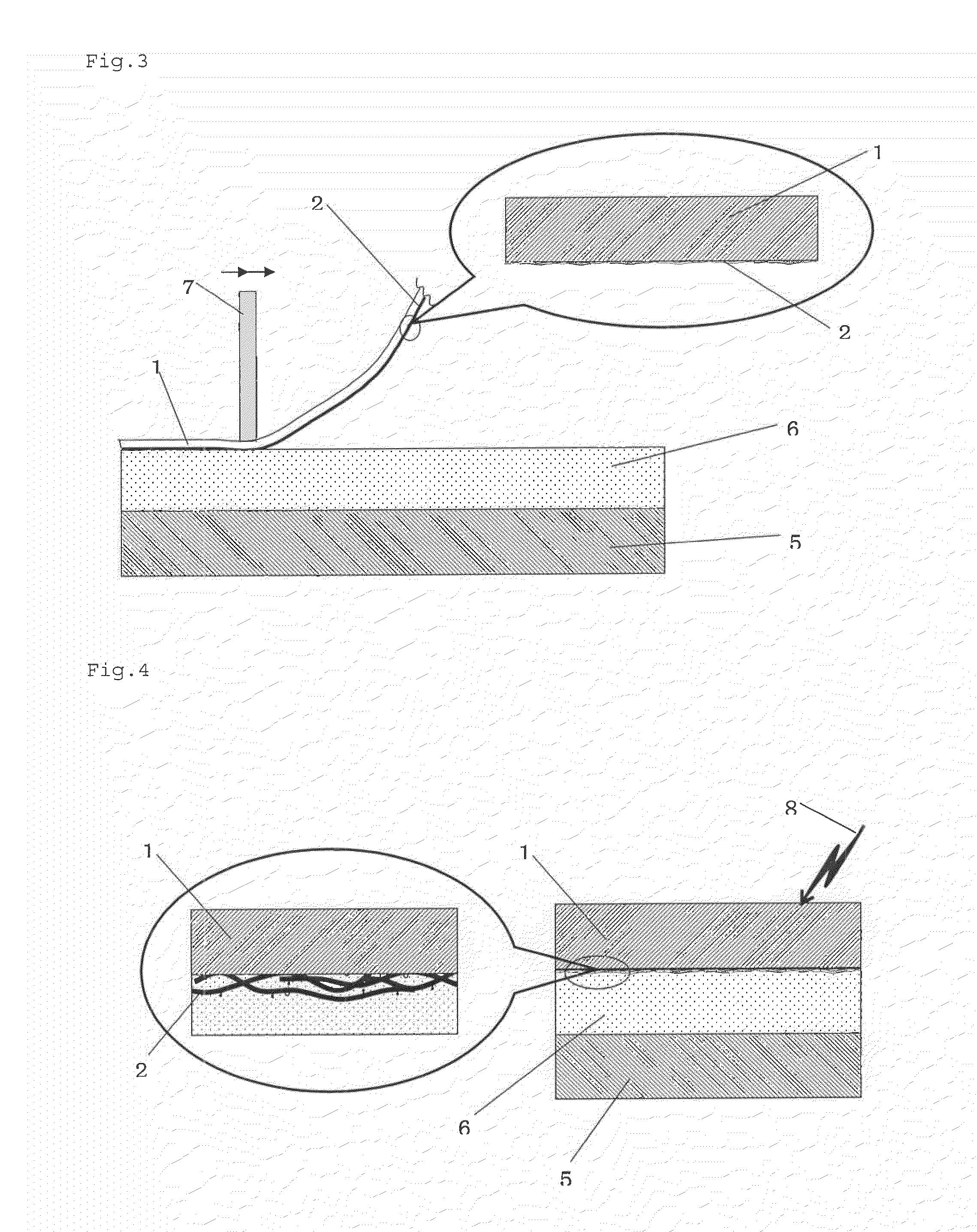Method for producing carbon nanotube-containing conductor
- Summary
- Abstract
- Description
- Claims
- Application Information
AI Technical Summary
Benefits of technology
Problems solved by technology
Method used
Image
Examples
example 1
(1) Formation of Release Substrate Having Carbon Network Layer
[0098]0.10 parts of SWNT FH-P (mean diameter: 2 to 3 nm, aspect ratio: 1000 to 5000, produced by Meijyo Nano Carbon) as single-walled carbon nanotubes and 0.60 parts of sodium alkylbenzenesulfonate (trade name: Neopelex G-65, produced by Kao) as a dispersant were added to 99.30 parts of water, and the mixture was dispersed using an ultrasonic disperser (trade name: UH 600, produced by SMT) set at an output power of 7, at a cooling water temperature of 10° C. The dispersion time was about 30 minutes when the mixture amount was 100 g. Next, 0.50 parts of polyether-modified polydimethylsiloxane (trade name: BYK 348, Produced by BYK Chemie) as a leveling agent was added to the ultrasonicated dispersion with stirring to prepare a dispersion for carbon nanotube network layer formation.
[0099]Subsequently, the dispersion for carbon nanotube network formation was applied onto a release substrate, UV-transmissive untreated PET film...
example 2
Physical Data Comparison in Change of Carbon Nanotube (CNT) Coating Amount
[0107]Objective substrates having a carbon nanotube-containing resin coating layer were produced under the same condition and according to the same operation method as in Example 1, except that the carbon nanotube coating amount was changed as shown in Table 3.
[0108]The CNT coating amount was a computed amount obtained according to the following formula:
Wet thickness with bar coater: Tw (μm)
Density of dispersion for carbon nanotube network layer formation:
G (g / cm3)
CNT concentration in dispersion for carbon nanotube network layer formation: C %
[0109]Table 3 also shows the physical data of these objective substrates which were evaluated in the same manner as in Example 1.
[Formula 1]
[0110]CNT coating amount (g / m2)=(Tw×G×C) / 100
TABLE 3Experiment 2Experiment 3Experiment 4Experiment 5CNT coating amount (g / m2)6.9 × 10−39.2 × 10−323.0 × 10−334.5 × 10−3Surface resistivity (Ω / square)2.3 × 105 7.8 × 104 9.5× 103 4.2 × 10...
example 3
Comparison in Drying Temperature in Carbon Nanotube Network Formation
[0112]Objective substrates of acryl plate having a carbon nanotube-containing resin coating layer were produced according to the same operation method as in Example 1, except that the drying temperature of 130° C. and the drying time of 1 minute after the bar coater coating with the aqueous solution for carbon nanotube network formation in (1) of Example 1 were changed as shown in Table 4.
[0113]Table 4 also shows the physical data of these objective substrates which were evaluated in the same manner as in Example 1.
TABLE 4Experiment 6Experiment 7Experiment 8Experiment 9Experiment 10Drying temperature (° C.)1101201506030Drying time (min)1 min1 min1 min3 min1 minSurface resistivity (Ω / square)2.3 × 1042.5 × 1042.7 × 1042.6 × 104*Whole light transmittance (%)87.687.687.387.5*Haze0.40.40.40.4*Pencil hardness5H5H5H5H*Adhesivenessclass 0class 0class 0class 0** Under the condition of 30° C. × 1 minute (Experiment 10), wate...
PUM
 Login to View More
Login to View More Abstract
Description
Claims
Application Information
 Login to View More
Login to View More - R&D
- Intellectual Property
- Life Sciences
- Materials
- Tech Scout
- Unparalleled Data Quality
- Higher Quality Content
- 60% Fewer Hallucinations
Browse by: Latest US Patents, China's latest patents, Technical Efficacy Thesaurus, Application Domain, Technology Topic, Popular Technical Reports.
© 2025 PatSnap. All rights reserved.Legal|Privacy policy|Modern Slavery Act Transparency Statement|Sitemap|About US| Contact US: help@patsnap.com



